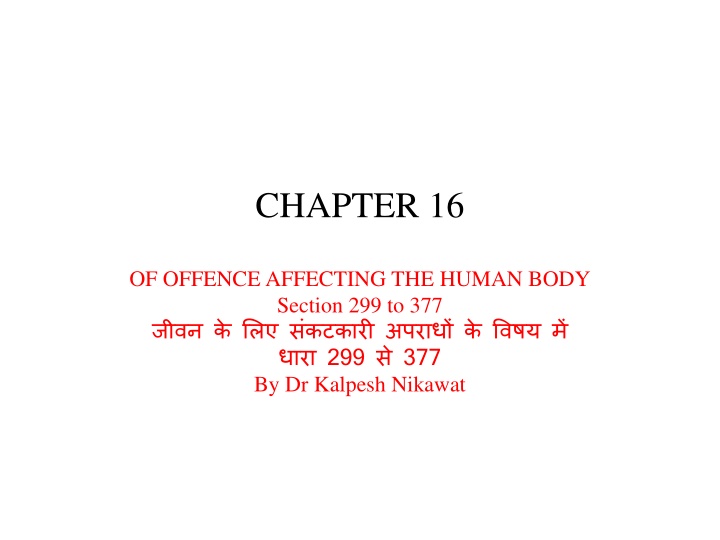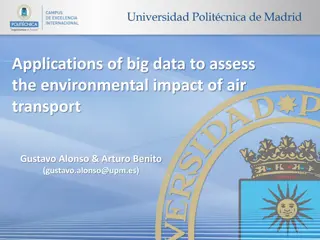
Offences Affecting the Human Body: Culpable Homicide and Murder Laws
Explore sections 299 to 377 of the Indian Penal Code dealing with offences affecting life, including culpable homicide and murder. Understand the legal definitions, illustrations, and explanations related to causing death intentionally or through bodily injury. Dive into the complexities of determining culpable homicide and murder under the law.
Download Presentation

Please find below an Image/Link to download the presentation.
The content on the website is provided AS IS for your information and personal use only. It may not be sold, licensed, or shared on other websites without obtaining consent from the author. If you encounter any issues during the download, it is possible that the publisher has removed the file from their server.
You are allowed to download the files provided on this website for personal or commercial use, subject to the condition that they are used lawfully. All files are the property of their respective owners.
The content on the website is provided AS IS for your information and personal use only. It may not be sold, licensed, or shared on other websites without obtaining consent from the author.
E N D
Presentation Transcript
CHAPTER 16 OF OFFENCE AFFECTING THE HUMAN BODY Section 299 to 377 299 377 By Dr Kalpesh Nikawat
Of offence affecting life The first part of this chapter dealing with offences affecting life have been covered under sections 299 to 311 of the code. 299 311
Culpable Homicide SECTION 299 Culpable homicide Whoever causes death by doing an act with the intention of causing death, or with the intention of causing such bodily injury as is likely to cause death, or with the knowledge that he is likely by such act to cause death, commits the offence of culpable homicide. 1 , 2 , , 3
Illustrations (a) A lays sticks and turf over a pit, with the intention of thereby causing death, or with the knowledge that death is likely to be thereby caused. Z believing the ground to be firm, treads on it, falls in and is killed. A has committed the offence of culpable homicide. (b) A knows Z to be behind a bush. B does not know it A, intending to cause, or knowing it to be likely to cause Z s death, induces B to fire at the bush. B fires and kills Z. Here B may be guilty of no offence; but A has committed the offence of culpable homicide. (c) A, by shooting at a fowl with intent to kill and steal it, kills B who is behind a bush; A not knowing that he was there. Here, although A was doing an unlawful act, he was not guilty of culpable homicide, as he did not intend to kill B, or to cause death by doing an act that he knew was likely to cause death.
Explanation Explanation 1. A person who causes bodily injury to another who is labouring under a disorder, disease or bodily infirmity, and thereby accelerates the death of that other, shall be deemed to have caused his death. Explanation 2. Where death is caused by bodily injury, the person who causes such bodily injury shall be deemed to have caused the death, although by resorting to proper remedies and skilful treatment the death might have been prevented. Explanation 3. The causing of the death of child in the mother s womb is not homicide. But it may amount to culpable homicide to cause the death of a living child, if any part of that child has been brought forth, though the child may not have breathed or been completely born , , , , , , , , , , , ,
MURDER SECTION 300 Except in the cases hereinafter excepted, culpable homicide is murder, if the act by which the death is caused is done with the intention of causing death, or (Secondly) If it is done with the intention of causing such bodily injury as the offender knows to be likely to cause the death of the person to whom the harm is caused, or (Thirdly) If it is done with the intention of causing bodily injury to any person and the bodily injury intended to be in- flicted is sufficient in the ordinary course of nature to cause death, or (Fourthly) If the person committing the act knows that it is so imminently dangerous that it must, in all probability, cause death or such bodily injury as is likely to cause death, and commits such act without any excuse for incurring the risk of causing death or such injury as aforesaid.
Illustrations (a) A shoots Z with the intention of killing him. Z dies in consequence. A commits murder. (b) A, knowing that Z is labouring under such a disease that a blow is likely to cause his death, strikes him with the intention of causing bodily injury. Z dies in consequence of the blow. A is guilty of murder, although the blow might not have been sufficient in the ordinary course of nature to cause the death of a person in a sound state of health. But if A, not knowing that Z is labouring under any disease, gives him such a blow as would not in the ordinary course of nature kill a person in a sound state of health, here A, although he may intend to cause bodily injury, is not guilty of murder, if he did not intend to cause death, or such bodily injury as in the ordinary course of nature would cause death. (c) A intentionally gives Z a sword-cut or club-wound sufficient to cause the death of a man in the ordinary course of nature. Z dies in consequence. Here, A is guilty of murder, although he may not have intended to cause Z s death. (d) A without any excuse fires a loaded cannon into a crowd of persons and kills one of them. A is guilty of murder, although he may not have had a premeditated design to kill any particular individual.
Exception 1 Exception 1. When culpable homicide is not murder. Culpable homicide is not murder if the offender, whilst deprived of the power of self-control by grave and sudden provocation, causes the death of the person who gave the provocation or causes the death of any other person by mistake or accident. The above exception is subject to the following provisos: (First) That the provocation is not sought or voluntarily provoked by the offender as an excuse for killing or doing harm to any person. (Secondly) That the provocation is not given by anything done in obedience to the law, or by a public servant in the lawful exercise of the powers of such public servant. (Thirdly) That the provocation is not given by anything done in the lawful exercise of the right of private defence.
Explanation Explanation . Whether the provocation was grave and sudden enough to prevent the offence from amounting to murder is a question of fact. Illustrations (a) A, under the influence of passion excited by a provocation given by Z, intentionally kills. Y, Z s child. This is murder, in as much as the provocation was not given by the child, and the death of the child was not caused by accident or misfortune in doing an act caused by the provocation. (b) Y gives grave and sudden provocation to A. A, on this provocation, fires a pistol at Y, neither intending nor knowing himself to be likely to kill Z, who is near him, but out of sight. A kills Z. Here A has not committed murder, but merely culpable homicide. (c) Ais lawfully arrested by Z, a bailiff. Ais excited to sudden and violent passion by the arrest, and kills Z. This is murder, in as much as the provocation was given by a thing done by a public servant in the exercise of his powers. (d) A appears as witness before Z, a Magistrate, Z says that he does not believe a word of A s deposition, and thatAhas perjured himself.Ais moved to sudden passion by these words, and kills Z. This is murder. (e) A attempts to pull Z s nose, Z, in the exercise of the right of private defence, lays hold of A to prevent him from doing so. Ais moved to sudden and violent passion in consequence, and kills Z. This is murder, in as much as the provocation was given by a thing done in the exercise of the right of private defence. (f) Z strikes B. B is by this provocation excited to violent rage. A, a bystander, intending to take advantage of B s rage, and to cause him to kill Z, puts a knife into B s hand for that purpose. B kills Z with the knife. Here B may have committed only culpable homicide, butAis guilty of murder.
Exception 2 Exception 2. Culpable homicide is not murder if the offender, in the exercise in good faith of the right of private defence of person or property, exceeds the power given to him by law and causes the death of the person against whom he is exercising such right of defence without premeditation, and without any intention of doing more harm than is necessary for the purpose of such defence. Illustration Z attempts to horsewhip A, not in such a manner as to cause grievous hurt to A. A draws out a pistol. Z persists in the assault. A believing in good faith that he can by no other means prevent horsewhipped, shoots Z dead. A has not committed murder, but only culpable homicide. himself from being
Exception 3. Exception murder if the offender, being a public servant or aiding a public servant acting for the advancement of public justice, exceeds the powers given to him by law, and causes death by doing an act which he, in good faith, believes to be lawful and necessary for the due discharge of his duty as such public servant and without ill-will towards the person whose death is caused. 3. Culpable homicide is not
Exception 4 Exception murder premeditation in a sudden fight in the heat of passion upon a sudden quarrel and without the offender having taken undue advantage or acted in a cruel or unusual manner. Explanation. It is immaterial in such cases which party offers the provocation or commits the first assault. 4. Culpable it homicide committed is without not if is
Exception 5. Exception 5. Culpable homicide is not murder when the person whose death is caused, being above the age of eighteen years, suffers death or takes the risk of death with his own consent. Illustration A, by instigation, voluntarily causes, Z, a person under eighteen years of age to commit suicide. Here, on account of Z s youth, he was incapable of giving consent to his own death; A has therefore abetted murder
Difference between Culpable Homicide and Murder Reg vs Govinda (1877) ILR 1 Bom 342 Justice Melvill In the present case the prisoner, a young man of 18, appears to have kicked his wife, (a girl of 15) and to have struck her several times with his fist on the back. These blows seem to have caused her no serious injury. She, however, fell on the ground, and I think that the evidence shows that the prisoner then put one knee on her chest, and struck her two or three times on the face. One or two of these blows, which, from the medical evidence, I believe to have been violent and to have been delivered with the closed fist, took effect on the girl's left eye, producing contusion and discoloration. The skull was not fractured, but the blow caused an extravagation of blood on the brain, and the girl died in consequence either on the spot, or very shortly afterwards. On this state of facts the Sessions Judge and the assessors have found the prisoner guilty of murder, and he has been sentenced to death. I am myself of opinion that the offence is culpable homicide, and not murder. I do not think there was an intention to cause death; nor do I think that the bodily injury was sufficient in the ordinary course of nature to cause death. Ordinarily, I. think, it would not cause death. But a violent blow in the eye from a man's fist, while the person struck is lying with his or her head on the ground, is certainly likely to cause death, either by producing concussion or extravasations of blood on the surface or in the substance of the brain. A reference to Taylor's Medical Jurisprudence (Fourth Edition, page 294) will show how easily life may be destroyed by a blow on the head producing extravasations of blood. For these reasons I am of opinion that the prisoner should be convicted of culpable homicide not amounting to murder, and I would sentence him to transportation for seven years.
Difference between 299 and 300 299299299 CH 300 MURDER A person commits culpable homicide, if the act by which the death is caused is done (a) With the intention of causing death; Subject homicide is murder, if the act by which the death is caused is done (1) With the intention of causing death; to certain exceptions, culpable (2) With the intention of causing such bodily injury as the offender knows to be likely to cause the death of the person to whom the harm is caused; 3) With the intention of causing bodily injury to any person, and the bodily injury intended to be inflicted is sufficient in the ordinary course of nature to cause death; (b) With the intention of causing such bodily injury as is likely to cause death: (c) With the knowledge that the act is likely to cause death. (4) With the knowledge that the act is so imminently dangerous that it must in all probability cause death, or such bodily injury as is likely to cause death.
Difference between 299 and 300 Culpable Homicide and Murder 1. 299(1) 300(1) have exactly the same language. This mean that whenever death is caused with the intention of causing death the liability is always murder. (Intentional causing death is always murder) 300(2) is a special separate clause in the sense that both intention and knowledge are relevant under it. 299(2)300(3) If the act by which the death is caused is done with the intention of causing such bodily injury as is likely to cause death, the offence is culpable homicide. When the bodily injury intended to be inflicted is sufficient in the ordinary course of nature to cause death the offence is murder. 299(3) 300(4) Death must be caused by doing an act with the knowledge that the accused is likely by such act to cause death. 300(4) Death must be caused by doing an act with the knowledge that act is so imminently dangerous that it must in all probability cause death. 2. 3. 4.
299(1) 300(1) 299 (1) 300 (1) 300(2) 299(2) 300(3) 299(2) 300(3) 299(3) 300(4)
















